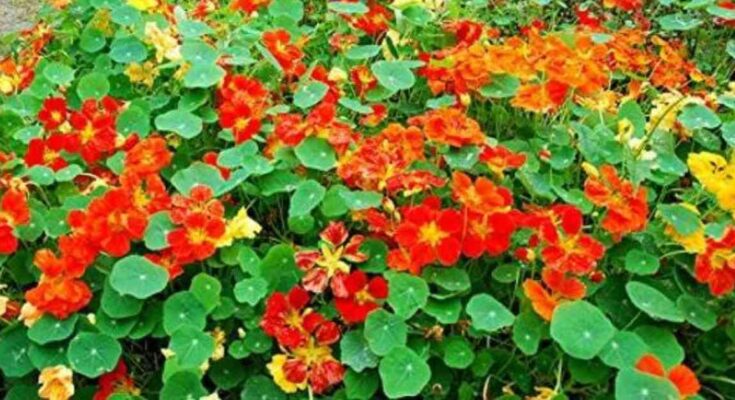Nasturtiums, with their vibrant blooms and versatile uses, are beloved by gardeners and chefs alike. This article explores everything you need to know about nasturtiums, from their origins and cultivation tips to their health benefits and culinary uses. Whether you’re a gardening enthusiast looking to add a splash of color to your garden or a culinary aficionado seeking to elevate your dishes with edible flowers, nasturtiums offer a wealth of possibilities.
Introduction to Nasturtiums
Nasturtiums (Tropaeolum majus) are annual flowering plants native to South America, particularly Peru and surrounding regions. They belong to the Tropaeolaceae family and are renowned for their vibrant flowers and round, shield-shaped leaves. Nasturtiums are easy to grow and are prized not only for their ornamental beauty but also for their culinary uses.
Cultivation and Care
Growing Conditions
Nasturtiums thrive in moderate climates and prefer well-drained soil with moderate fertility. They can tolerate various soil types but perform best in slightly sandy or loamy soil. Choose a sunny location for optimal flowering, though they can tolerate partial shade.
Planting
- Seeds: Nasturtium seeds are large and easy to handle, making them ideal for direct sowing. Plant seeds directly into the soil after the last frost date, spacing them about 10-12 inches apart.
- Transplanting: Alternatively, you can start seeds indoors 4-6 weeks before the last frost and transplant them outdoors once the weather warms up.
Care
- Watering: Keep the soil consistently moist but not waterlogged. Water deeply when the top inch of soil feels dry.
- Fertilization: Nasturtiums are light feeders. A balanced fertilizer applied once a month during the growing season is usually sufficient.
- Pest and Disease Control: Nasturtiums are generally pest-resistant but can occasionally attract aphids. Companion planting with marigolds or herbs like basil can help deter pests naturally.
Varieties of Nasturtiums
Nasturtiums come in a variety of cultivars, offering different flower colors and growth habits:
- Alaska Series: Known for their variegated foliage and bright flowers in shades of red, orange, and yellow.
- Empress of India: Features deep crimson flowers with dark foliage, adding a dramatic flair to garden borders.
- Whirlybird Series: Double-flowered varieties in a range of colors, from creamy whites to deep oranges.
Health Benefits of Nasturtiums
Nasturtiums aren’t just pretty flowers; they also offer several health benefits:
- Rich in Vitamins: Nasturtium leaves are high in vitamin C and contain significant amounts of vitamin A and iron.
- Antibacterial Properties: Studies suggest that nasturtiums may have antibacterial properties, particularly against certain strains of bacteria.
- Antioxidant Content: The flowers and leaves of nasturtiums contain antioxidants that help protect cells from damage by free radicals.
Culinary Uses
Nasturtiums are prized in the culinary world for their peppery flavor and vibrant color. Both the flowers and leaves are edible, offering a spicy kick similar to watercress. Here are some ways to incorporate nasturtiums into your culinary creations:
- Salads: Add nasturtium flowers and leaves to salads for a peppery bite and a splash of color.
- Garnishes: Use whole flowers or individual petals to garnish appetizers, soups, and main dishes.
- Stuffed Flowers: Fill nasturtium flowers with herbed cream cheese or other savory fillings for a visually stunning appetizer.
Nasturtium in Folklore and Tradition
Throughout history, nasturtiums have held symbolic meanings and practical uses:
- Medicinal Uses: In traditional medicine, nasturtiums were used to treat various ailments, from respiratory issues to skin infections.
- Symbolism: Nasturtiums have been associated with courage, conquest, and victory, likely stemming from their vibrant appearance and resilience in different environments.
Conclusion
Nasturtiums are more than just beautiful flowers; they are versatile plants that offer both aesthetic appeal and culinary delights. Whether you’re planting them in your garden for their vibrant blooms, harvesting them for their health benefits, or using them to elevate your culinary creations, nasturtiums are sure to add a touch of color and flavor to your life. With their easy cultivation, rich history, and numerous uses, nasturtiums are a must-have for any gardener or food enthusiast looking to explore the world of edible flowers.




